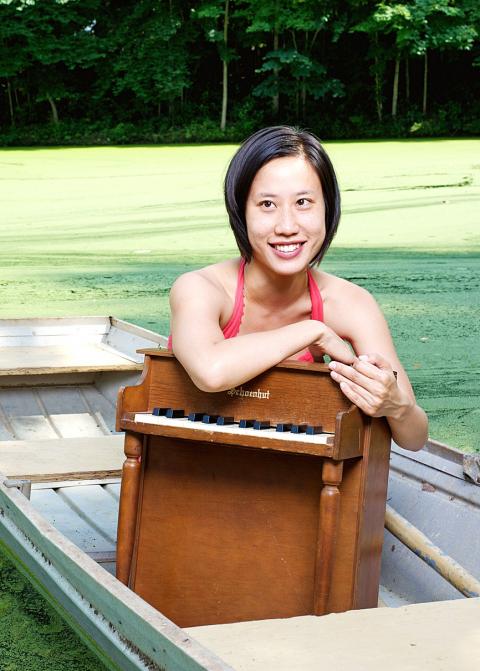As a classically trained pianist, Phyllis Chen knew her way around a grand piano from a young age. But then she saw her first toy piano — and life took on a whole new dimension.
Toy pianos are child-size, some no bigger than a music box. And while they might be in the shape of a grand, they can be picked up by one person, possibly even by one hand.
Chen, though, realized the little instrument’s outsize potential and before long she was joining the thin, but growing ranks of a toy piano subculture.

Photo: AFP / KIMONO PHOTOGRAPHY / HO
Her first encounter with this odd instrument was at a puppet theater in Chicago. The mini-piano was a set piece, in scale to the characters of the show. Then Chen, 33, walked up to it and played a note.
“I just touched the key and I just fell in love with the sound right away,” she said.
She was 21 at the time and already something of an experimenter. For example, she was a fan of “prepared piano,” which involves placing objects inside the body of the piano to change its sound.
The toy piano, with its quirky look and percussive, chiming tone, was a revelation.
“This can spark the imagination for people in a lot of different ways,” she said. “It’s an unassuming instrument. In a way, it’s like a found object.”
Toy pianos, also known as kinderklaviers, or children’s keyboards, have been around in their present form since the late 19th century.
Albert Schoenhut, a German immigrant to Philadelphia who founded the famous toy piano manufacturer that bears his name, built his first model using child-resistant metal rather than the glass parts found in earlier toy pianos in 1872.
Children are the most obvious users of these tiny instruments. In the Peanuts comic strip, Schroeder is often pictured seated at a toy piano.
However, they’re becoming increasingly popular with musically adventurous adults. Chen guesses maybe 20 professional musicians perform on the toy piano as part of their contemporary music-making. Others use it in for movies and independent bands.
While parents and grandparents are still big customers, “orders from professionals have been pouring in,” said Renee Trinca, who owns Schoenhut with her husband, Len.
Chen, who composes and is a founding member of the International Contemporary Ensemble, has also helped to promote the instrument.
The UnCaged Toy Piano composition competition she founded became a full-fledged festival this year with three concerts in Manhattan.
There, pianists like Margaret Leng Tan, Takuji Kawai and Chen tickled the mini-ivories — actually plastic keys — for listeners who frequently smiled with delight.
“There’s a whole new generation of young toy pianists now on the scene,” said Tan, a longtime champion of the instrument who notes that this year will bring a world toy piano summit at the Philharmonie Luxembourg. “It has now become a new genre that’s taken on a life of its own.”
Chen’s goal with her annual competition is to generate new music for an instrument that has been mostly overlooked by major composers, with John Cage and George Crumb being two notable exceptions. Cage’s pioneering Suite for Toy Piano (1948) uses just nine notes.
Composer David Smooke, who chairs the music theory department at Peabody, performed a piece he wrote at the festival’s closing concert.
He said the toy piano was “exploding” in popularity, particularly over the last two years, in a similar way to the ukulele.
“I think people are looking for these instruments that are associated with childhood and nostalgia and trying to bring those to the forefront,” Smooke said. “I’m kind of shocked at the number of people I’m finding all over the world who are getting into it.”
Chen got serious about the toy piano at the start of her DMA program at Indiana University, when a bout with tendonitis forced her to stop playing piano altogether.
As she began to play again while undergoing physical therapy, she found the toy piano, with its small size and lighter touch, to be “rehabilitative.” It also inspired her as a composer.
She has since released two solo toy piano CDs and played toy piano as the featured solo musician for the off-Broadway show Coraline.
She still loves the instrument’s singular sound, which has drawn comparisons to the glockenspiel, harpsichord, bells and even cellphone — and which results from the metal rods, not strings, that are struck when keys are played.
It’s a small sound — “intimate,” said Chen — though it can be amplified. Toy pianos come in a variety of sizes and Chen’s tiniest model has only 10 keys. However, rather than feel limited by fewer notes, she said she felt freed from the centuries of tradition and myriad recordings associated with the 88-key piano.
“It’s hard to feel like it’s completely fresh, for me, when I play the piano,” Chen said. “The toy piano feels a little bit more like it’s being invented now. It’s a language that’s of today and there’s no preconceived idea about it.”

Taiwan Semiconductor Manufacturing Co (TSMC, 台積電) last week recorded an increase in the number of shareholders to the highest in almost eight months, despite its share price falling 3.38 percent from the previous week, Taiwan Stock Exchange data released on Saturday showed. As of Friday, TSMC had 1.88 million shareholders, the most since the week of April 25 and an increase of 31,870 from the previous week, the data showed. The number of shareholders jumped despite a drop of NT$50 (US$1.59), or 3.38 percent, in TSMC’s share price from a week earlier to NT$1,430, as investors took profits from their earlier gains

In a high-security Shenzhen laboratory, Chinese scientists have built what Washington has spent years trying to prevent: a prototype of a machine capable of producing the cutting-edge semiconductor chips that power artificial intelligence (AI), smartphones and weapons central to Western military dominance, Reuters has learned. Completed early this year and undergoing testing, the prototype fills nearly an entire factory floor. It was built by a team of former engineers from Dutch semiconductor giant ASML who reverse-engineered the company’s extreme ultraviolet lithography (EUV) machines, according to two people with knowledge of the project. EUV machines sit at the heart of a technological Cold

AI TALENT: No financial details were released about the deal, in which top Groq executives, including its CEO, would join Nvidia to help advance the technology Nvidia Corp has agreed to a licensing deal with artificial intelligence (AI) start-up Groq, furthering its investments in companies connected to the AI boom and gaining the right to add a new type of technology to its products. The world’s largest publicly traded company has paid for the right to use Groq’s technology and is to integrate its chip design into future products. Some of the start-up’s executives are leaving to join Nvidia to help with that effort, the companies said. Groq would continue as an independent company with a new chief executive, it said on Wednesday in a post on its Web

CHINA RIVAL: The chips are positioned to compete with Nvidia’s Hopper and Blackwell products and would enable clusters connecting more than 100,000 chips Moore Threads Technology Co (摩爾線程) introduced a new generation of chips aimed at reducing artificial intelligence (AI) developers’ dependence on Nvidia Corp’s hardware, just weeks after pulling off one of the most successful Chinese initial public offerings (IPOs) in years. “These products will significantly enhance world-class computing speed and capabilities that all developers aspire to,” Moore Threads CEO Zhang Jianzhong (張建中), a former Nvidia executive, said on Saturday at a company event in Beijing. “We hope they can meet the needs of more developers in China so that you no longer need to wait for advanced foreign products.” Chinese chipmakers are in